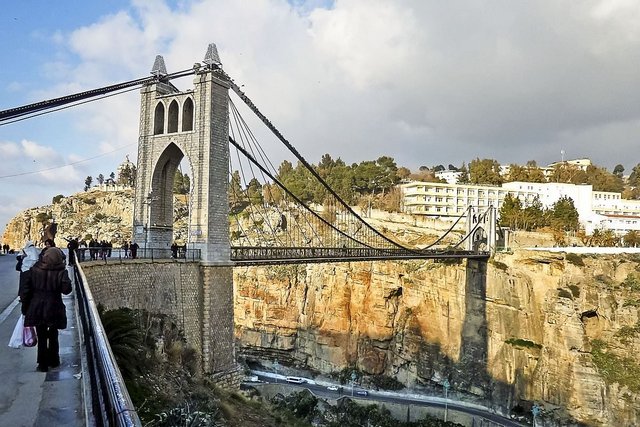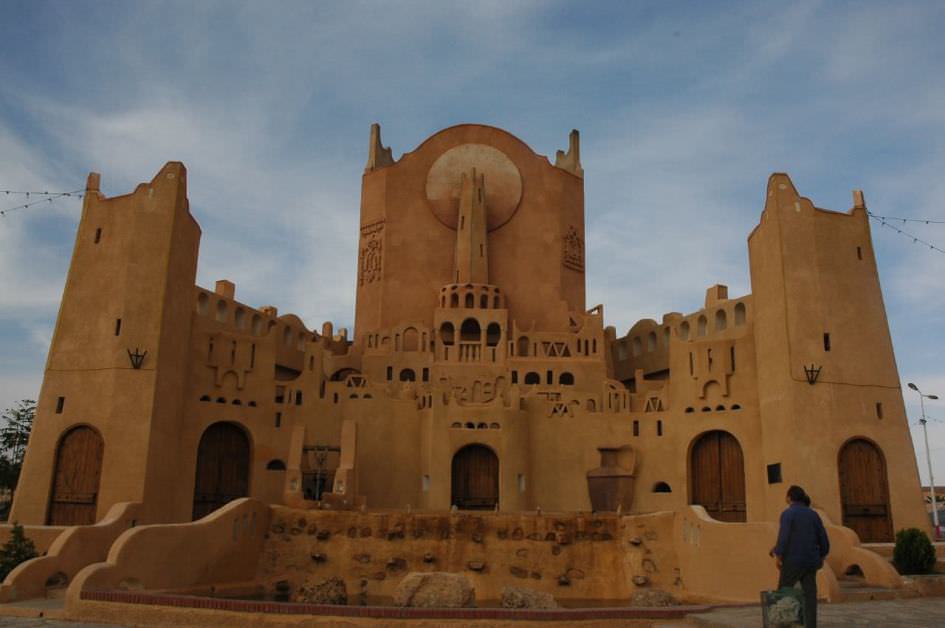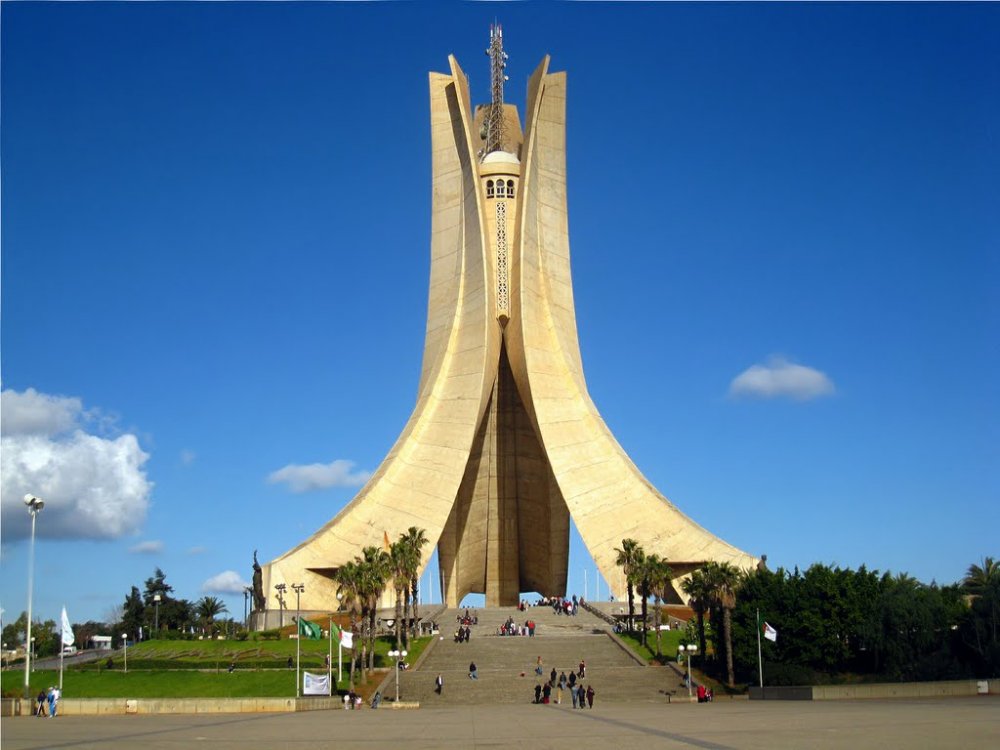Tourism in Algeria is considered one of the most captivating experiences in the North African region. This destination offers a plethora of breathtaking tourist attractions that encompass stunning beaches, majestic mountains, vast deserts, enriching museums, and historical sites that trace back to the Andalusian and Phoenician eras.
Constantine city

Constantine city, also known as Qacentina or Qacentini in Arabic, is a historic and culturally rich city located in northeastern Algeria. It is often referred to as the “City of Bridges” due to the numerous bridges that span the deep gorge carved by the Rhumel River.
Constantine is renowned for its picturesque setting, with the city perched on cliffs overlooking the river. Its strategic location made it a significant center throughout history, attracting various civilizations, including the Phoenicians, Romans, Byzantines, and Arabs.
The city is home to many notable attractions, such as the iconic Sidi M’Cid Bridge, a marvel of architecture that connects different parts of the city. The Qasr El-Bey, a former palace turned museum, showcases a rich collection of historical artifacts, art, and traditional crafts.
Constantine is also famous for its vibrant cultural heritage. The annual International Festival of Arab and Andalusian Music attracts musicians and performers from around the world. Visitors can explore the winding streets of the Casbah, the old quarter, with its traditional houses, mosques, and bustling markets.
Additionally, Constantine has a strong academic presence, with several universities and research institutions. The city is known for its intellectual and artistic contributions to the country.
Overall, Constantine offers a unique blend of natural beauty, historical significance, and cultural richness, making it a captivating destination for tourists and a source of pride for Algeria.
Ghardaia city

Ghardaia is a captivating city located in the M’zab Valley in central Algeria. It is the principal city of the M’zab region, which is recognized as a UNESCO World Heritage site due to its exceptional architecture and cultural significance.
The city of Ghardaia is renowned for its unique and well-preserved medieval urban structure, characterized by five ancient fortified towns, known as “ksour,” built on hilltops. These ksour include Ghardaia, Melika, Beni Isguen, Bou Noura, and El Atteuf, each with its distinct charm and atmosphere.
The architecture of Ghardaia reflects the indigenous Ibadi Muslim culture and showcases the ingenious use of local materials. The distinctive structures are made of sun-baked bricks and feature intricate designs, narrow streets, and terraces that offer stunning panoramic views of the surrounding valley.
Ghardaia’s old town, known as the “M’zab,” is a maze-like network of alleys, squares, and courtyards, where traditional houses are interconnected, providing shade and shelter from the desert climate. The central mosque, Great Mosque of Ghardaia, stands as a prominent landmark with its elegant minaret.
The city’s cultural heritage is deeply rooted in the Ibadi faith, and its inhabitants maintain a traditional way of life. The indigenous Mozabite Berber people, who have inhabited the region for centuries, follow their own customs, traditions, and social organization.
Ghardaia is also known for its lively markets, where locals trade a variety of goods, including handicrafts, textiles, spices, and fresh produce. Visitors can immerse themselves in the vibrant atmosphere, interact with the friendly locals, and purchase unique souvenirs.
The picturesque landscapes surrounding Ghardaia, with the Sahara Desert on one side and the Atlas Mountains on the other, offer opportunities for exploration and outdoor activities. Visitors can take guided tours to nearby oases, experience camel rides, or simply enjoy the tranquility of the desert.
In summary, Ghardaia is a captivating city that offers a glimpse into the rich cultural heritage of the M’zab region. Its unique architecture, traditional way of life, and stunning natural surroundings make it an alluring destination for travelers seeking an authentic Algerian experience.
Annaba city

Annaba is a vibrant coastal city located in northeastern Algeria. Situated on the Mediterranean Sea, it is known for its beautiful beaches, historical sites, and lively atmosphere. Annaba has a rich history and offers a range of attractions for visitors to explore.
One of the highlights of Annaba is its stunning coastline, with pristine sandy beaches stretching along the Mediterranean. Rizi-Amor Beach and Ain Achir Beach are popular spots for swimming, sunbathing, and enjoying water sports. Visitors can relax by the azure waters or take in the breathtaking views of the sea.
The city is also home to several notable historical and cultural sites. The Basilica of St. Augustine, an ancient Roman Catholic basilica dating back to the 4th century, is a significant landmark and a pilgrimage site for many. The ruins of Hippo Regius, an ancient Roman city and the birthplace of St. Augustine, offer a glimpse into the city’s past.
Annaba’s city center, known as the Baladía, is a bustling area with lively markets, shops, and restaurants. Visitors can explore the narrow streets, sample local cuisine, and experience the vibrant atmosphere of the city. The Place du 1er Novembre is a central square where locals and tourists gather to relax and enjoy the surroundings.
For nature enthusiasts, the Edough National Park, located just outside Annaba, offers opportunities for hiking and exploring diverse ecosystems. The park features rugged mountains, lush forests, and scenic trails that provide stunning views of the surrounding landscapes.
Annaba is also known for its vibrant cultural scene. The city hosts numerous festivals throughout the year, showcasing local music, dance, and traditions. The International Festival of Annaba attracts artists from around the world, offering a diverse range of performances and exhibitions.
Annaba combines natural beauty, historical significance, and a lively atmosphere, making it a captivating destination for travelers. Whether it’s relaxing on the beaches, exploring historical sites, or immersing oneself in the local culture, Annaba has something to offer for every visitor.
Tlemcen city

Tlemcen is a city located in northwestern Algeria, near the border with Morocco. It is the capital of Tlemcen Province and has a rich history and cultural heritage. Here’s some information about Tlemcen:
Historical Significance:
Tlemcen has a long history dating back to ancient times. It was originally founded by the Berbers and later became an important city during the reign of the Almoravid dynasty in the 11th century. The city flourished under the Almoravids and the subsequent Almohad dynasty, serving as a center of Islamic learning and culture.
Architecture and Landmarks:
Tlemcen is known for its impressive architectural heritage. One of its most famous landmarks is the Grand Mosque of Tlemcen, also known as the Great Mosque of Sidi Boumediene. This mosque dates back to the 12th century and is a masterpiece of Almoravid architecture. Another notable site is the Mansourah Mosque, built by the Almohads in the 13th century.
Mansourah:
Located near Tlemcen, Mansourah is an ancient fortified city that was founded by the Almohad dynasty. It served as the capital of the kingdom during the 13th century. Today, the ruins of Mansourah stand as a testament to its historical importance.
Islamic Art and Culture:
Tlemcen has a rich tradition of Islamic art and culture. The city is known for its intricate woodwork, calligraphy, and zellij (mosaic tilework). The art of Tlemcen is heavily influenced by Andalusian and Moroccan styles, creating a unique blend of architectural and artistic elements.
Music and Literature:
Tlemcen has been a center of music and literature throughout its history. The city is known for its traditional music, particularly the Andalusian genre, which combines Arabic, Berber, and Spanish influences. Tlemcen has also produced renowned scholars, poets, and writers who have made significant contributions to Arabic literature.
Local Cuisine:
Tlemcen is famous for its delicious cuisine, which reflects the region’s diverse culinary influences. Some popular dishes include couscous, tajine (slow-cooked stew), and various meat-based dishes. Tlemcen is also known for its sweet pastries and desserts.
Modern City:
While preserving its historical heritage, Tlemcen has also developed into a modern city with amenities and infrastructure. It has a university, museums, parks, and a vibrant market where visitors can experience the local culture and shop for traditional handicrafts.
Tlemcen is a city that offers a blend of history, art, culture, and natural beauty. Its historical sites, cultural events, and warm hospitality make it a fascinating destination for travelers interested in exploring Algeria’s rich heritage
The city of Oran

Oran is a vibrant coastal city located in northwestern Algeria. It is the second largest city in the country and serves as a major port and commercial center. Known for its rich history, beautiful beaches, and lively atmosphere, Oran attracts both tourists and locals alike. Here are some key aspects of the city:
History:
Oran has a fascinating history that dates back to ancient times. It was originally founded by the Berbers and later came under the rule of various civilizations, including the Romans, Vandals, and Arabs. Over the centuries, it experienced periods of prosperity and was influenced by different cultures, leaving behind a diverse architectural heritage.
Architecture:
Oran showcases a mix of architectural styles, reflecting its historical influences. The city’s old town, known as “La Casbah,” features narrow streets, traditional houses, and charming squares. The Great Mosque of Oran, a prominent landmark, showcases beautiful Islamic architecture. You can also find French colonial buildings, such as the Santa Cruz Fort, which offers panoramic views of the city and the Mediterranean Sea.
Beaches:
Oran is blessed with stunning beaches along its coastline. Les Andalouses Beach, one of the most popular beaches, boasts golden sands and crystal-clear waters. Other notable beaches include Ain El Turck Beach, Bou Sfer Beach, and Les Coralines Beach. These areas offer opportunities for swimming, sunbathing, and water sports.
Culture and Entertainment:
Oran is renowned for its vibrant cultural scene. The city is famous for its music, particularly raï music, a genre that originated in Oran and blends traditional Algerian music with Western influences. There are numerous music festivals and events throughout the year, showcasing local talent. Oran is also known for its lively street markets, where you can find a variety of local crafts, spices, and textiles.
Food:
Algerian cuisine is diverse and flavorful, and Oran is no exception. The city offers a wide range of delicious dishes influenced by Berber, Arab, and French culinary traditions. Some popular dishes include couscous, tajine, pastilla, and various types of grilled meats. Don’t miss the opportunity to try local delicacies and explore the vibrant food scene in Oran.
Nearby Attractions:
Oran serves as a gateway to other fascinating destinations in the region. You can visit the Tlemcen city, known for its beautiful Islamic architecture and UNESCO World Heritage sites, including the Grand Mosque and the ruins of Mansourah. The Santa Cruz Basilica in nearby Algiers is another notable attraction. If you’re interested in nature, the Tafraoui Oasis and the Mers El Kebir beach are worth exploring.
When visiting Oran, it’s important to respect local customs and traditions. Arabic is the official language, but French is widely spoken. The local currency is the Algerian dinar (DZD), and the city has a Mediterranean climate with hot summers and mild winters.
Overall, Oran offers a captivating blend of history, culture, and natural beauty, making it an intriguing destination for travelers seeking an authentic Algerian experience.
The city of Algiers

The capital, Algiers, is one of the most beautiful tourist cities in Algeria. It comprises two distinct sections: a modern area and an archaeological site. Algiers is also home to a diverse range of world-renowned tourist attractions, including the Shrine of the Martyr, the Kasbah, the Bardo Museum of Algeria, the Algerian Army Museum, and the Ben Aknoun National Park.
Here are some key features and attractions you can discover in Algiers:
Kasbah of Algiers:
This UNESCO World Heritage site is a historic citadel that dates back to the 17th century. It consists of narrow streets, traditional houses, and beautiful architecture, offering a glimpse into Algiers’ past.
Notre Dame d’Afrique:
This stunning basilica, situated on a hilltop overlooking the city and the Mediterranean Sea, is a symbol of religious harmony and offers breathtaking panoramic views.
Martyrs’ Memorial (Shrine of the Martyr): This monumental landmark commemorates the Algerian War of Independence and honors those who sacrificed their lives for freedom. The memorial stands tall on the hill of the Martyrs, providing an impressive sight.
The Great Mosque of Algiers: Known as the Ketchaoua Mosque, this architectural gem showcases a blend of Moorish and Byzantine styles. It has a fascinating history and is a significant religious site.
Le Jardin d’Essai du Hamma:
This botanical garden is a peaceful oasis in the city, featuring a wide array of plant species, beautiful paths, and serene ponds. It’s an ideal spot for a relaxing stroll.
Casbah Square:
Located in the heart of the old town, Casbah Square offers a glimpse into Algiers’ traditional way of life. You can explore the bustling markets, indulge in local cuisine, and soak in the vibrant atmosphere.
The National Museum of Antiquities:
This museum houses a vast collection of archaeological artifacts that showcase Algeria’s ancient history, including Phoenician, Roman, and Islamic artifacts.
Algiers Corniche:
Take a leisurely walk along the Corniche promenade, which stretches along the stunning Mediterranean coastline. Enjoy the sea views, visit restaurants and cafes, or simply relax on the beaches.
Algiers Modern Art Museum:
If you appreciate contemporary art, this museum is worth a visit. It showcases works by Algerian and international artists, providing insight into the modern art scene of the country.
The Monument of the Emir Abdelkader:
This impressive statue pays homage to Emir Abdelkader, a prominent Algerian religious and military leader known for his resistance against French colonization.
These are just a few highlights of what you can discover in Algiers. The city offers a unique blend of history, culture, and natural beauty, making it an enticing destination for travelers.
Did you like this article? Do not hesitate to share it on social networks and subscribe to Discover the World on Google News to not miss any articles!